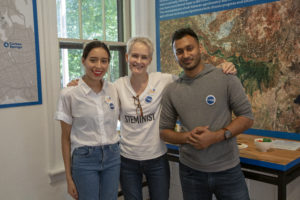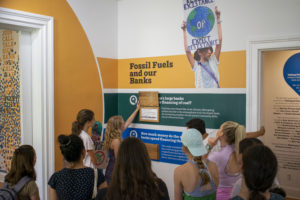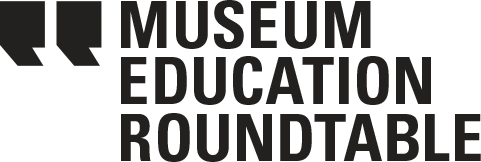Museum Programming for Civic Engagement on Climate Change with Miranda Massie
Interviewed by Anais Reyes
This guest post is authored by The Climate Museum, inspired by the JME issue 45.1, Museums and Public Climate Action. The Climate Museum is the first museum in the US dedicated to climate change. Through exhibitions, public art installations, youth programs, panels and workshops with experts, and more, the Museum uses programming as a way to expand the public conversation on climate solutions and collective action. The Climate Museum’s blog is definitely worth following, particularly their recent post “Black Lives and the Climate Crisis: Resources” and its related public program.
In this blog post, we explore the Museum’s approach to programming and public engagement through a conversation between Miranda Massie, the museum’s Director and founder, and Anais Reyes, the museum’s Exhibitions Associate.

Anais Reyes: What would you say are the core beliefs behind our programming at the Climate Museum?
Miranda Massie: Our programming aims to give people of all ages an accessible entrypoint into the climate conversation. Formally, our mission is to inspire action on the climate crisis with programming across the arts and sciences that deepens understanding, builds connections, and advances just solutions. At our core, we’re working to build a wider culture of climate-forward thinking and active engagement. This is why we invite people to take action at our exhibitions—as you know, at our last show, Taking Action, we invited groups of visitors to take one or more of five specific actions including calling on their senators and representative to take the No Fossil Fuel Money pledge, talking to three people about climate change, and joining a climate-forward organization. It’s necessary but no longer sufficient to educate people on the science and the nature of the emergency, or to connect with their emotions through art. We need to get people involved in meaningful, public-facing actions. According to the most recent polling from a few months ago, 66% of Americans say they are worried about global warming, but only 5% of us discuss it regularly; our programming aims to move that worried-but-silent 61% toward a more active engagement.
Anais: Our programming also tries to show visitors that they don’t have to be scientists or be experts in science to talk about climate change. Climate is connected to art, media, activism, community, nature, everyday life—and it’s important to get everyone on level ground by acknowledging that this could be and needs to be a much bigger, more common, more multifaceted public conversation.
Miranda: Yes, and a more inclusive conversation. Which is why we have things like Climate Speaks and other youth arts programs, for example—to capture the voices that are still often disregarded. Young people are increasingly and rightly aware that their future is sharply at stake and it’s voices like that we try to elevate.
Anais: How would you say the programming approach of the Climate Museum differs from other museums?
Miranda: We explore climate change and its impacts through a very interdisciplinary lens—unlike what you might see in a traditional science, natural history, or art museum. As you said, climate is related to every part of our lives, so talking about how it is connected to different social problems and even personal values or interests is important to creating that more robust, nuanced understanding of the crisis and moving people to action. We also understand that museums dealing with subjects like the climate crisis cannot be neutral spaces, and we want the Climate Museum to be an agent of positive social change. Educating about climate change and climate solutions is inherently connected to politics, and we don’t shy away from political conversations.
Anais: With the climate crisis worsening—and even with the recent explosion of dialogue around racial and social justice—we really can’t afford to. We talk about ourselves as an “activist museum”; what does that phrase mean to you?
Miranda: It means that through our dialogue and interaction with visitors, we provide guided pathways into action that feel meaningful, and that those actions join you with a community that is bigger than yourself. Because we need a massive new wave of climate engagement, we must foreground that push for action with each and every program we present. It’s about creating a sense of civic engagement and connection, and collective possibility, within and between our museum visitors.
Anais: What are the advantages of asking people to engage with a challenging topic in a museum space?

Miranda: The power of museum programming is foundational to our theory of change. Studies have shown that the public perceives museums to be highly reliable sources of information, both in general and on climate. And we know that students who participate in museum field trips display improved critical thinking skills and greater tolerance and empathy toward others. In our case, the trustworthiness, prosocial qualities, and even the general, and remarkable, popularity of museums make them a powerful tool for reshaping the public’s understanding of the climate crisis and catalyzing collective action. We’re also heartened by studies that show that asking visitors to take mission-consistent action enhances the immense public trust that museums hold.
Anais: Exhibitions can also make challenging information more approachable, interactive, and even fun—though I’ll admit not all of the conversations we have can center around fun.
Miranda: Not all of them can be fun—we have to be honest about what we’re facing and respect our community’s intelligence, as you and I have often discussed in curating different projects—but when you do something prosocial, especially in a communal setting, it’s often a positive, hopeful, and empowering experience—one that people enjoy and value. Last year, visitors reported finding the opportunity to take collective action deeply meaningful, and they left the show with a sense of resolve—hope with toughness, perhaps, or to pull from a more recent program, our discussion ‘Black Lives and the Climate Crisis,’ a sense of courage.
Anais: So what can readers at home do about climate change?
Miranda: You can begin by talking about it. It’s easy to feel overwhelmed by the scale of the issue, but it’s not too late for us to implement effective climate solutions. Talking with people you know builds community and leads to increased public support for large-scale changes. We just have to start with acknowledging the elephant in the room. Today, most Americans agree with you that it is happening, so it really doesn’t have to be an intimidating topic. Remember you’re not alone in fighting for a better future.
Anais: It may also be helpful to share that—first of all—over 97% of climate scientists agree about the reality of human-caused climate change, meaning that you don’t have to spend your conversation breaking down the chemistry or science behind it all, you can just start with recent news or what you’re feeling. Second of all, the source of the crisis is the fossil fuel economy, and not your individual consumer choices, so you shouldn’t feel stuck or guilty about driving a car or enjoying bacon. Blaming yourself incorrectly shifts historic responsibility. Basically, there are bigger fish to fry in all of this than plastic straws.
Miranda: Yes. This is why we as a Museum prioritize outward-facing civic solutions, such as climate-forward voting and advocacy, joining or donating to climate organizations, and, like I said, spreading the word. We as a society must recenter our culture and policies around social justice and climate progress, and that starts with people coming together to create collective change.
Miranda Massie is the Director of the Climate Museum. She left a career as a civil rights impact litigator to found the Museum in 2014, with honors including Fletcher Foundation, W.E.B. Dubois Institute and Harvard Law School Wasserstein Public Interest Fellowships and a Mentorship-in-Residence at Yale Law School.
Anais Reyes is the Exhibitions Associate at the Climate Museum. She has previously worked at the American Museum of Natural History, the New Museum, and the Whitney Museum. She received a B.F.A. from the University of Wisconsin-Madison, and is currently studying ecology at Columbia University.

